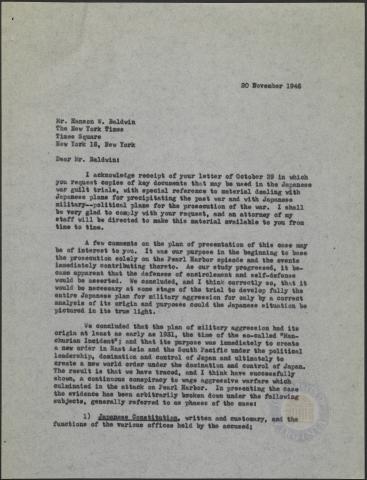
Page 1
| Parent | Outline of prosecution |
|---|---|
| Date | 20 November 1946 |
| Language | English |
| Collection | Tavenner Papers & IMTFE Official Records |
| Box | Box 3 |
| Folder | General Reports and Memoranda from November 1946 |
| Repository | University of Virginia Law Library |
20 November 1946
Mr. Hanson W. Baldwin
The New York Times
Times Square
New York 18, New York
Dear Mr. Baldwin:
I acknowledge receipt of your letter of October 29 in which you request copies of key documents that may be used in the Japanese war guilt trials, with special reference to material dealing with Japanese plans for precipitating the past war and with Japanese military – political plans for the prosecution of the war. I shall be very glad to comply with your request, and an attorney of my staff will be directed to make this material available to you from time to time.
A few comments on the plan of presentation of this case may be of interest to you. It was our purpose in the beginning to base the prosecution solely on the Pearl Harbor episode and the events immediately contributing thereto. As our study progressed, it became apparent that the defenses of encirclement and self-defense would be asserted. We concluded, and I think correctly so, that it would be necessary at some stage of the trial to develop fully the entire Japanese plan for military aggression for only by a correct analysis of its origin and purposes could the Japanese situation be pictured in its true light.
We concluded that the plan of military aggression had its origin at least as early as 1931, the time of the so-called “Manchurian Incident”; and that its purpose was immediately to create a new order in East Asia and the South Pacific under the political leadership, domination and control of Japan and ultimately to create a new world order under the domination and control of Japan. The result is that we have traced, and I think have successfully shown, a continuous conspiracy to wage aggressive warfare which culminated in the attack on Pearl Harbor. In presenting the case the evidence has been arbitrarily broken down under the following subjects, generally referred to as phases of the case:
1)Japanese Constitution, written and customary, and the functions of the various offices held by the accused;
